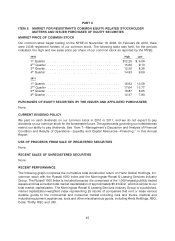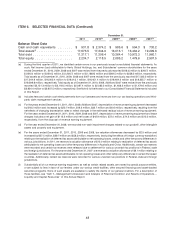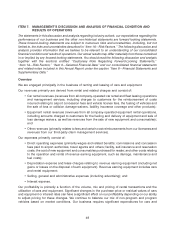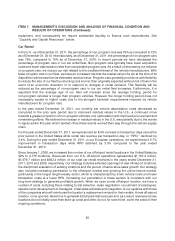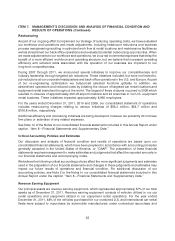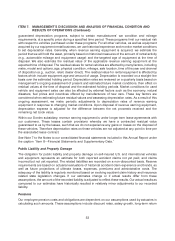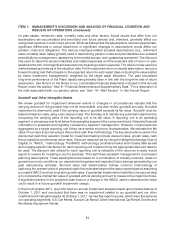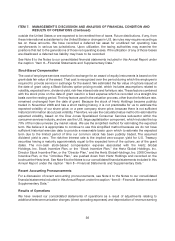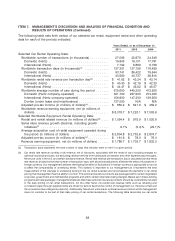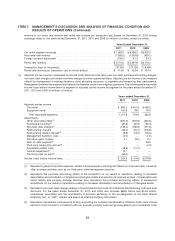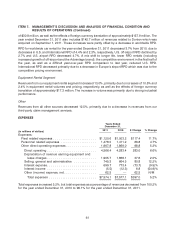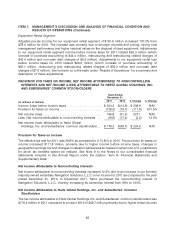Hertz 2011 Annual Report Download - page 81
Download and view the complete annual report
Please find page 81 of the 2011 Hertz annual report below. You can navigate through the pages in the report by either clicking on the pages listed below, or by using the keyword search tool below to find specific information within the annual report.ITEM 7. MANAGEMENT’S DISCUSSION AND ANALYSIS OF FINANCIAL CONDITION AND
RESULTS OF OPERATIONS (Continued)
We performed the impairment analyses for our reporting units, using our business and long-term
strategic plans, revised to reflect the current economic conditions. Our weighted-average cost of capital
used in the discounted cash flow model was calculated based upon the fair value of our debt and our
stock price with a debt to equity ratio comparable to our industry. The total fair value of our reporting
units was then compared to our market capitalization to ensure their reasonableness.
We re-evaluate the estimated useful lives of our intangible assets annually or as circumstances change.
Those intangible assets considered to have indefinite useful lives, including our trade name, are
evaluated for impairment on an annual basis, by comparing the fair value of the intangible assets to their
carrying value. Intangible assets with finite useful lives are amortized over their respective estimated
useful lives. In addition, whenever events or changes in circumstances indicate that the carrying value of
intangible assets might not be recoverable, we will perform an impairment review.
The valuation of our indefinite-lived assets utilized the relief from royalty method, which incorporates
cash flows and discount rates comparable to those discussed above. We also considered the excess
earnings as a percentage of revenues to ensure their reasonableness. Our analysis supported our
conclusion that an impairment did not exist.
See Note 3 to the Notes to our consolidated financial statements included in this Annual Report under
the caption ‘‘Item 8—Financial Statements and Supplementary Data.’’
Derivatives
We periodically enter into cash flow and other hedging transactions to specifically hedge exposure to
various risks related to interest rates, fuel prices and foreign currency rates. Derivative financial
instruments are viewed as risk management tools and have not been used for speculative or trading
purposes. All derivatives are recorded on the balance sheet as either assets or liabilities measured at
their fair value. The effective portion of changes in fair value of derivatives designated as cash flow
hedging instruments is recorded as a component of other comprehensive income. The ineffective
portion is recognized currently in earnings within the same line item as the hedged item, based upon the
nature of the hedged item. For derivative instruments that are not part of a qualified hedging relationship,
the changes in their fair value are recognized currently in earnings. The valuation methods used to mark
these to market are either market quotes (for fuel swaps and foreign exchange instruments) or a
discounted cash flow method (for interest rate swaps and interest rate caps). The key inputs for the
discounted cash flow method are the current yield curve and the credit default swap spread. These
valuations are subject to change based on movements in items such as the London inter-bank offered
rate, or ‘‘LIBOR,’’ our credit worthiness and unleaded gasoline and diesel fuel prices.
Income Taxes
Deferred tax assets and liabilities are recognized for the future tax consequences attributable to
differences between the financial statement carrying amounts of existing assets and liabilities and their
respective tax bases. Deferred tax assets and liabilities are measured using enacted tax rates expected
to apply to taxable income in the years in which those temporary differences are expected to be
recovered or settled. The effect of a change in tax rates is recognized in the statement of operations in
the period that includes the enactment date. Valuation allowances are recorded to reduce deferred tax
assets when it is more likely than not that a tax benefit will not be realized. Subsequent changes to
enacted tax rates and changes to the global mix of earnings will result in changes to the tax rates used to
calculate deferred taxes and any related valuation allowances. Provisions are not made for income taxes
on undistributed earnings of international subsidiaries that are intended to be indefinitely reinvested
55


